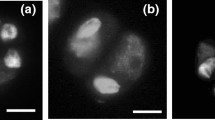Abstract
Some of the factors governing seed-set in three populations ofLythrum salicaria are examined during two seasons. Plants spatially segregated from legitimate neighbours by distances exceeding 1m set few seeds. Plants with small inflorescences set fewer seeds than those with medium or large inflorescences. Flowers having self pollen applied to the stigma before legitimate pollination set fewer seed per flower than those pollinated with legitimate pollen only. Seeds of the mid-style morph germinated more effectively than those of the long style morph and seeds of the short-style morph showed very low levels of germination.
Similar content being viewed by others
References
Barrett, S. C. H., 1979: The evolutionary breakdown of tristyly inEichhornia crassipes (Mart.)Solms (Water Hyacinth). — Evolution33, 499–510.
Baker, H. G., 1958: Studies in the reproductive biology of West AfricanRubiaceae. — J. W. African Sci. Ass.4, 9–24.
Bawa, K. S., Beach, J. H., 1981: The evolution of sexual systems in flowering plants. — Ann. Missouri Bot. Gard.68, 254–278.
Bolz, M., 1983:Menyanthes trifoliata L. — Diploma-work. Institute for Systematic Botany University of Zürich.
Casper, B. B., Charnov, E. L., 1982: Sex allocation in heterostylous plants. — J. Theoret. Biol.96, 143–149.
Charnov, E. L., 1983: The Theory of Sex Allocation. — Princeton, New Jersey: University Press.
Darwin, C., 1877: The Different Forms of Flowers on Plants of the Same Species. — London: John Murray.
Ford, E. B., 1964: Ecological Genetics. — London: Methuen.
Ganders, F. R., 1979: The biology of heterostyly. — New Zealand J. Bot.17, 607–636.
Haldane, J. B. S., 1936: Some natural populations ofLythrum salicaria. — J. Genetics32, 393–397.
Halkka, O., Halkka, L., 1974: Polymorphic balance in small island populations ofLythrum salicaria. — Acta Bot. Fenn.11, 267–270.
Heuch, I., 1980: Loss of incompatibility types in finite populations of the heterostylous plantLythrum salicaria. — Hereditas92, 53–57.
Levin, D. A., 1970: Assortative pollination inLythrum. — Amer. J. Bot.57, 1–5.
—, 1972: Pollen exchange as a function of species proximity inPhlox. — Evolution26, 251–258.
—, 1973: Assortative pollination for stature inLythrum salicaria. — Evolution27, 144–152.
Mulcahy, D. L., Caporello, D., 1970: Pollen flow within a tristylous species:Lythrum salicaria. — Amer. J. Bot.57, 1027–1030.
Nettancourt, D. de, 1977: Incompatibility in Angiosperms. — Berlin, New York: Springer.
Nicholls, M. S., 1985: Pollen flow, population composition and the adaptive significance of distyly inLinum tenuifolium L. (Linaceae). — Biol. J. Linn. Soc.25, 235–242.
—, 1986: Pollen flow, gender specialization and the adaptive significance of distyly inLinum perenne (Linaceae). — New Phytol.102, 209–217.
Ockendon, D. J., Currah, L., 1977: Self pollen reduces the number of cross-pollen tubes in the styles ofBrassica oleracea L. — New Phytol.78, 675–680.
Price, S. D., Barrett, S. C. H., 1984: The function and adaptive significance of tristyly inPontederia cordata L. (Pontederiaceae). — Biol. J. Linn. Soc.21, 315–329.
Thompson, J. D., Andrews, B. J., Plowright, R. C., 1981: The effect of a foreign pollen on ovule development inDiervilla lonicera (Caprifoliaceae). — New Phytol.90, 777–783.
Waser, N. M., 1978: Competition for hummingbird pollination and sequential flowering in two Colorado wildflowers. — Ecology56, 934–944.
Vuilleumier, B. S., 1967: The origin and evolutionary development of heterostyly in the angiosperms. — Evolution21, 210–226.
Yeo, P. F., 1975: Some aspects of heterostyly. — New Phytol.75, 147–153.
Author information
Authors and Affiliations
Rights and permissions
About this article
Cite this article
Nicholls, M.S. Pollen flow, self-pollination and gender specialization: Factors affecting seed-set in the tristylous speciesLythrum salicaria (Lythraceae). Pl Syst Evol 156, 151–157 (1987). https://doi.org/10.1007/BF00936070
Received:
Issue Date:
DOI: https://doi.org/10.1007/BF00936070




